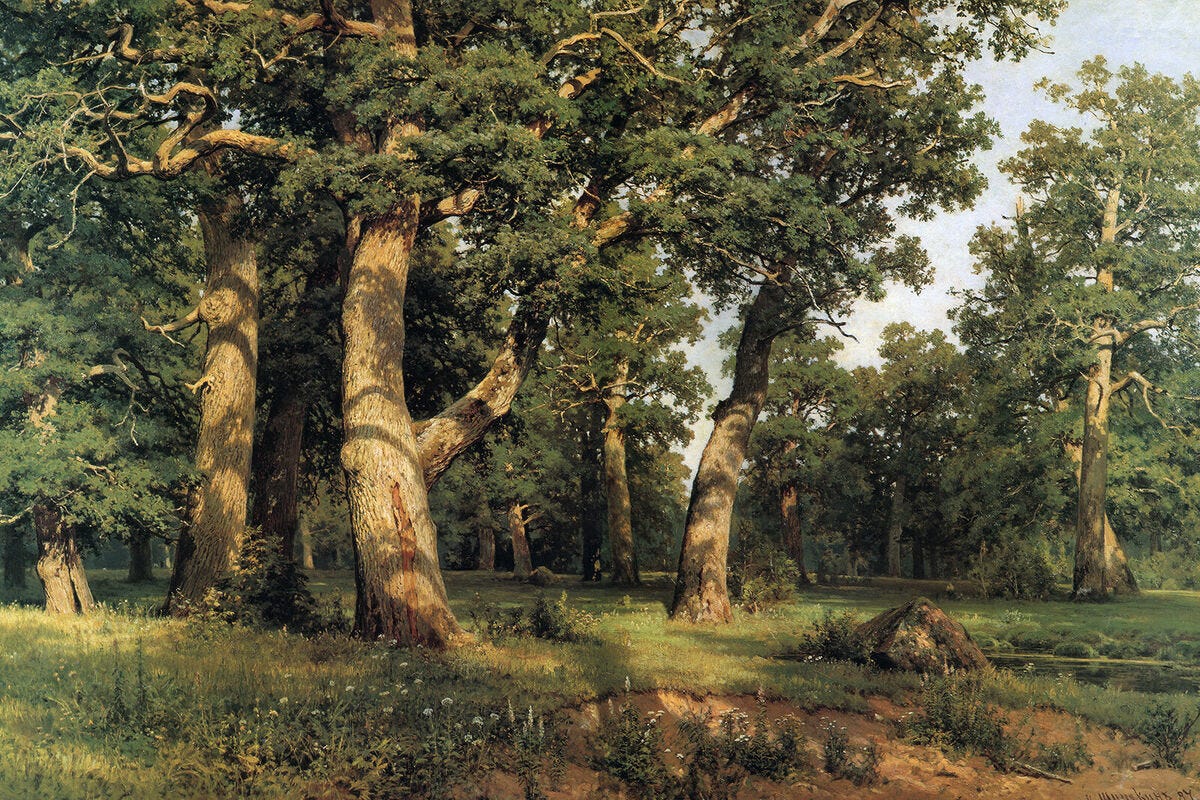Last year, I went on a road trip with my family to Niagara. The waterfalls, American and Canadian, without saying, were awe inspiring; an incredible constant of raw power. Yet, on the drive there and back, to my surprise I found my interest cheaply piqued by the trees. Not just any, but the betula papyrifera, paper birch, or American white birch tree. Of course I’d seen them before, the lone white birch here and there around parts of my home state Pennsylvania. What had surprised me in upper western New York was seeing them in small groves.

The white birch fancies northward due to its high-temperature intolerance. Which would explain why Russian landscape painter Ivan Shishkin features them — a lot of them — of the European variety in his works. I only became familiar through an “𝕏” bot account sprinkling my feed with his paintings. An attempt to help offset the offensively bad trash there.
Calming, idyllic, and inviting comes to mind for the works of Shishkin. The calming allure is just as strong in his depiction of oaks, one of which has been my lock screen for several years now. And each one of his paintings normally have accompanying names just as simple as the middle painting above: Birch Grove, 1896. It feels a little crass to call these “simple” but it does feel the most fitting word.
Many others, even of his time, would even go a step further to call this “excessive naturalism” or a sort of photography that’s hardly art. And some truth is in this critique, as Shishkin would use photographs as reference and even advocated for using photos to better yourself as a painter. Yet he’s apparently said, "a mediocre artist will slavishly copy all the unnecessary detail from photos, but a man with a flair will take only what he needs." So now what’s to make of him?
My idea is not to argue on some technicality that it is or isn’t art, but to poke fun at those who would dismiss a Shishkin painting. I sense the same sort of person who would quickly turn up their nose to Shishkin’s style, as old or bland, would emphatically agree a Rothko or Pollock is art (and I happen to like Pollock too). Don’t both styles, modern abstract and Russian landscape, bring their own simplicity to the art table? Where one brings a splash or square of color, the Shishkin brings a tree, a path in the woods, or a field of rye. In a word, both bring out beauty in simplicity.
Perhaps I’m a little biased as an amateur film photographer, and the photographic-like charm scratch an itch of mine. Regardless, I’m reminded of a funny admission by Russian filmmaker, Andrey Tarkovsky in his book Sculpting in Time. For background, this is a filmmaker who would include long sequences of nature. Sometimes four or six minutes long! An eternity by today’s movie standards. Anyhow, in this book he addresses some questions he’s asked about his films. One of course being, what the nature sequences mean. The fact there’s rain or streams and what this means and so on. Tarkovsky flatly states there’s no meaning behind this. They’re just of nature and it’s beauty. They just are.
It feels, in the West, for better and worse, we swim against a long cultural stream of criticality and examination. It’s reflexive for us to examine and ask the reason of things. Small simple things put up no argument at all for themselves. It’s no question the beauty of the Niagara falls, why there’s a long promenade filled with people, at night light shows flare them up in a whole array of color. Of course they’re beautiful. The white birch grove along the road? How’s this beautiful? Explain.
I’ll end with an anecdote shared by Professor Henri Nouwen in The Genesee Diary.
When Beethoven had played a new sonata for a friend, the friend asked him after the last note, “what does it mean?” Beethoven returned to the piano, played the whole sonata again and said, “that’s what it means!”






Wonderful thoughts here! Mixes my favorite things: art and nature, and does so in a fun, thoughtful way.